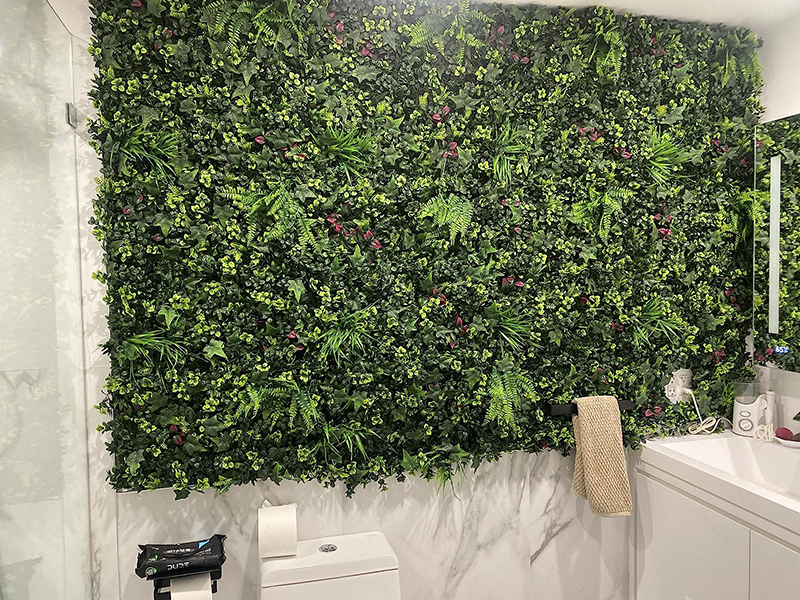3D artificial vertical gardens offer endless possibilities for creative expression, transforming mundane spaces into vibrant, eco-friendly installations. By combining artistic vision with functional design, these gardens can address urban challenges like air pollution, noise reduction, and biodiversity loss while enhancing aesthetic appeal. Below are examples of imaginative vertical garden designs that push the boundaries of traditional green walls.
One striking approach to vertical garden design involves modular systems that allow for reconfiguration and interactivity. For instance, a project in a public plaza might feature hexagonal panels that can be rearranged to form seasonal patterns or community art displays. Each module incorporates artificial plants with varying textures and colors, creating a living mosaic that evolves over time.
To engage visitors, some modules could integrate sensors that respond to touch or motion, triggering subtle movements in the foliage or lighting effects. This interactive dimension transforms the garden into a dynamic public space, encouraging exploration and fostering a connection between people and nature. Additionally, modular designs simplify maintenance, as damaged panels can be replaced individually without disrupting the entire installation.
Designers often draw inspiration from natural ecosystems to create themed vertical gardens that evoke specific environments, such as rainforests, deserts, or alpine meadows. A rainforest-themed garden might use artificial ferns, bromeliads, and vines to mimic lush canopy layers, while incorporating LED lighting to simulate dappled sunlight. Soundscapes of birdsong or flowing water could enhance the immersive experience.
Conversely, a desert-themed garden might feature cacti, succulents, and rocky textures, paired with warm-toned lighting to evoke arid landscapes. These themed installations not only serve as artistic statements but also educate the public about global biodiversity. By using artificial plants, designers can replicate rare or endangered species without ethical or ecological concerns.
Creative vertical gardens often serve dual purposes, blending greenery with practical functions like acoustic insulation, air purification, or energy generation. In a busy urban area, a vertical garden might double as a noise barrier, using thick layers of artificial foliage to absorb sound waves. The design could incorporate acoustic panels hidden within the plant modules, reducing traffic or construction noise for nearby residents.
Another example is a vertical garden integrated with solar-powered lighting or photovoltaic cells. The artificial plants could be designed with translucent materials that allow sunlight to reach embedded solar panels, generating renewable energy to power streetlights or signage. This fusion of sustainability and design innovation demonstrates how vertical gardens can contribute to broader urban resilience goals.
Some vertical gardens transcend traditional flat surfaces by incorporating kinetic or sculptural elements. A kinetic garden might feature rotating panels that shift with wind currents, creating ever-changing patterns of light and shadow. The artificial plants on these panels could be arranged to mimic the movement of natural flora, such as swaying grasses or dancing ferns.
Sculptural vertical gardens take this a step further by integrating three-dimensional forms, such as spirals, waves, or geometric shapes. For example, a spiral-shaped garden installed on a building corner could use artificial ivy or climbing vines to soften the structure’s edges while drawing the eye upward. These designs challenge conventional notions of vertical gardens as mere wall coverings, positioning them as architectural focal points.
Innovative designs also address the need for adaptability in response to climate change or urban growth. A vertical garden in a flood-prone area might use waterproof modules that can withstand temporary submersion, paired with artificial plants that resist mold and mildew. During dry spells, the garden could incorporate drip irrigation systems powered by rainwater harvesting, ensuring resilience in variable conditions.
Similarly, a vertical garden in a rapidly developing neighborhood might be designed for easy expansion. Modular panels could be added horizontally or vertically as the surrounding area grows, allowing the garden to scale without compromising its aesthetic or functional integrity. This adaptability ensures that vertical gardens remain relevant and effective in evolving urban landscapes.
The creative potential of 3D artificial vertical gardens is limited only by imagination. From interactive modular systems and themed landscapes to multi-functional utilities and kinetic sculptures, these installations redefine the role of greenery in urban spaces. By blending art, science, and sustainability, designers can create vertical gardens that inspire, educate, and improve quality of life. As cities continue to grow, innovative vertical garden designs will play a vital role in shaping greener, more livable environments.

Contact: Amy
Phone: 86-15311787313
E-mail: info@foszmac.com
Whatsapp:86-15311787313
Add: Fengtai District, Dacheng Road, No.24 Building, Room 203, Beijing, China